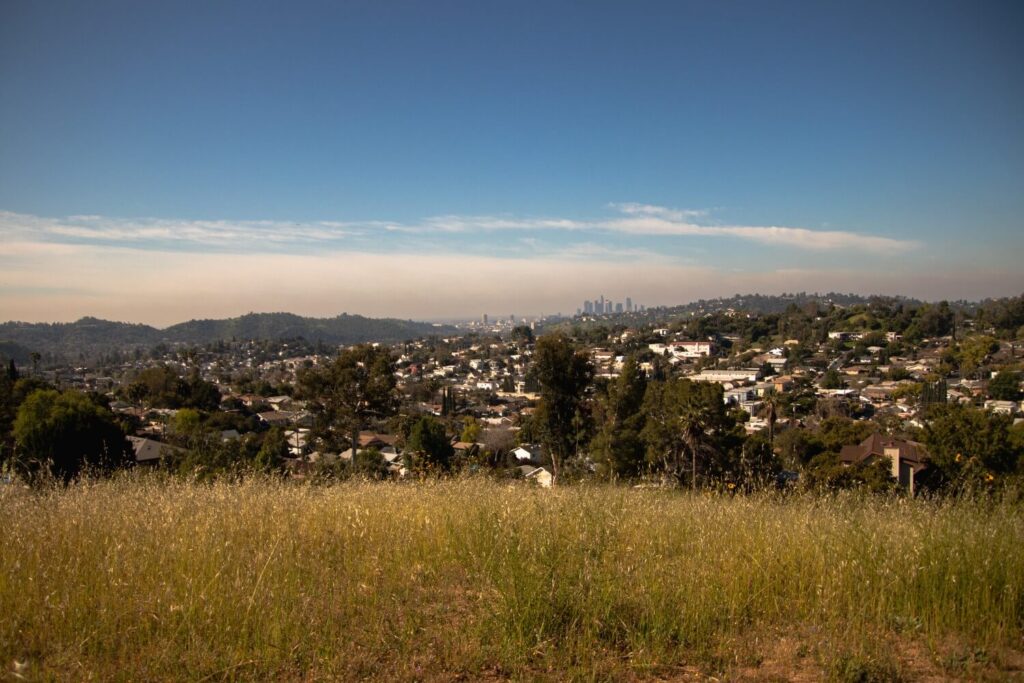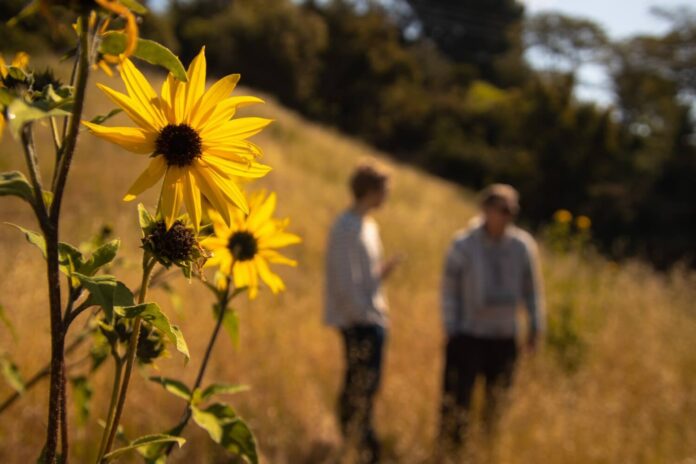In 1906, farmers Julia Strickland and Jacob Strickland opened their Highland Park Farm near Poppy Peak to several orphaned boys, creating a community based around the land.
John Vangelisti, who lives in Highland Park near the old farm, now the Optimist Home for Boys, said he is still finding community around open space in the neighborhood.
“They believed that nature would heal,” Vangelisti said. “Nature heals the emotions, and builds community. And that was the idea of 120 years ago.”
Vangelisti is part of Save Poppy Peak, a coalition of community members fighting for the protection of Poppy Peak, an undeveloped space accessible by nearby Strickland Avenue and a few other neighborhood streets. The hillside became the center of community organization and protest right after it became the prospective sight of a new batch of houses in March 2020.

Vangelisti said that the wildlife of the area is essential for the overall well-being of residents: mental and spiritual. In the 1970s, a friend of his mother ran a group for survivors of domestic violence and considered Poppy Peak a place of healing, where she lead sunset meditations, according to Vangelisti.
“Talking to people that grew up here, everybody had a field where they would play,” Vangelisti said. “And everyone had that sort of special place, a special tree. I always ask people, what tree did you first fall in love with?”
For Vangelisti, it was the Mother Oak, an oak on Poppy Peak Drive, believed to be the oldest in the area. He is worried that the experience he had with nature will not be around for future generations.
Save Poppy Peak started in March 2020 when local resident John Collinson looked up from a sink of dishes one afternoon to see surveying stakes on the hillside (Collinson is an Occidental alum from ’89). Collinson, now the co-chair of the Highland Park Neighborhood Council’s Land Use Committee, said he soon discovered that a developer had purchased 16 parcels of land, comprising of at least seven acres.
Collinson said the developer began building two luxury homes, now complete, on E. Annan Way, and filed permits for five more in January 2023. No further houses have yet been built on the plots.
According to Zillow, one house sold for $1.4 million and the other for $1.32 million. The median home price for Northeast LA was $1.14 million in November, according to the Boulevard Sentinel.
Collinson said he obtained a December 2017 correspondence between the GeoTech Services of Glendale on behalf of the developer and the LA Department of Building and Safety which discussed four houses as a first phase of development in a project which could include 40 more houses. Collinson came from a non-profit background, including jobs at the Natural History Museum and LA Zoo, but was new to development law and began networking with other land activists.
Collinson said that according to the California Environmental Quality Act (CEQA), which sets out guidelines and requirements meant to inform policymakers about the environmental consequences of potential development, dividing a project into two or more CEQA evaluations is “piecemealing,” and is explicitly forbidden by CEQA. If further development is planned, the whole project would need to be reviewed in one environmental document, according to the definition of a project under CEQA. Collinson said that if the two houses are a “phase one,” and there are plans for the development of the rest of the land, then the development has constituted a violation of CEQA.
According to Collinson, in February 2023 the LA Department of City Planning sent the developer a letter reflecting that the applications were incomplete, and the plans for the rest of the land needed to be accounted for.
Collinson said he is confident that the CEQA violation and additional measures required for further development will hinder construction.
Collinson said he is concerned about the large amount of dirt removal that will be required for the projects, the dump trucks that will need to drive up the narrow street and other neighborhood disturbances that the construction would cause, such as the noise disturbance of hydraulic hammering.
“I do recognize the irony of my land battles, my land activism and the fact that I live in one of the newer houses in the neighborhood, that is a hillside home,” Collinson said.
Collinson said he was also concerned for the native flora and fauna, including 44 oak trees across Poppy Peak. Collinson said that when a protected tree is cut down, it must be replaced with four saplings. One oak was cut down for the building of the first two houses. The four saplings behind the house are all planted close together, and one is already dying, Collinson said.
According to Dan Cooper, senior biologist at the Resource Conservation District of the Santa Monica Mountains, who Collinson hired to do a wildlife survey of the area, the hill bears scars of the past. He said the legacy of grazing and plowing for fire abatement is evident from the flora of the hillside, but it still has a lot of biodiversity.
“Hiding out in those weeds are some cool wildflowers,” Cooper said. “We documented some different lupines and cryptantha. There’s a lotus, a native pea. They’re hiding out.”
Cooper said that for biodiversity, the size of a plot is extremely important. He said that the habitat Poppy Peak provides might be dwarfed by Elysian Park, for example, but it’s still important to preserve any possible habitat.
“I think the trick is to get people to value this stuff,” Cooper said. “If you ask people on the edges of Poppy Peak what they loved about Poppy, they’ll go on, but two blocks away in either direction, they really wouldn’t have a concept of that. And that’s a shame.”
Arturo Rojas, another co-founder of Save Poppy Peak, said he sees people on the hill almost every day, but believes that it is used mainly by residents of the directly surrounding streets.
Cooper said that Poppy Peak is hidden, and not particularly accessible, and while this is in some sense a shame, there also needs to be a balance between the amount of use and capacity for maintenance.
“There’s not a management budget in any of these organizations to really handle an Instagram-popular site,” Cooper said.
Rojas said that what he values most about the land is the wildlife. He said he used to see plenty of snakes on the hillside, and even once saw a desert tortoise. Since then, however, the city plowed the hill for fire abatement, and he now sees mostly gophers, he said.
Still, there is much nature that stands to be lost in development, he said. He regularly sees red tail hawks, hummingbirds, possums and coyotes.
“And then we have the biggest guy, the skunk,” Rojas said. “If anybody rules this land, it’s this guy.”
Rojas said that living in his house for 34 years, he has still never felt connected to his neighbors before Save Poppy Peak.
“Poppy Peak is bringing the community together,” Rojas said.
Vangelisti said he sees the open hills as a connection to the land and its history, to the way things used to be and the way wildlife used to travel. He said he wants to someday see wildlife habitat a 15-minute walk from any residence in LA, and to create and conserve wildlife corridors, which he refers to as the emerald necklace. He sees Poppy Peak as a part of this, a place for wildlife to pass through and take refuge.
“This is one of the jewels. All these parks, all these land struggles are these jewels,” Vangilisti said. “That’s our kind of moral imperative, to save these jewels, and share them, and not to bury them.”
Contact Mostyn Trudinger-Smith at mtrudingersm@oxy.edu
![]()



































